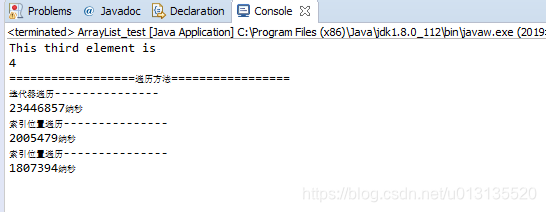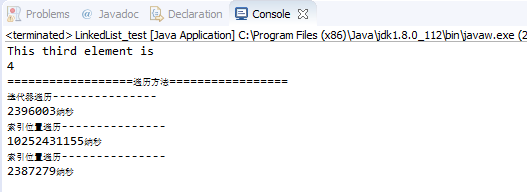List 实现了collection接口
ArrayList
- 以数组实现的列表,不支持同步
- 利用索引位置可以快速定位访问
- 不适合指定位置的插入、删除操作
- 适合变动不大的,主要用于查询的数据
- 和java数组相比,其容量是可以动态调整的
- ArrayList在元素填满容器的时会自动扩充容器大小的50%
import java.util.ArrayList;
import java.util.Iterator;
public class ArrayList_test {
public static void main(String[] args) {
ArrayList<Integer> al=new ArrayList<Integer>();
al.add(3);
al.add(2);
al.add(1);
al.add(4);
al.add(5);
al.add(6);
al.add(new Integer(6));
System.out.println("This third element is ");
System.out.println(al.get(3));
al.remove(3);
al.add(3,9);
System.out.println("==================遍历方法=================");
ArrayList<Integer> al2=new ArrayList<Integer>(100000);
for(int i=0;i<100000;i++){
al2.add(i);
}
traverByIterator(al2);
traverByIndex(al2);
traverByFor(al2);
}
public static void traverByIterator(ArrayList<Integer> al){
System.out.println("迭代器遍历---------------");
long startTime = System.nanoTime();
Iterator iter=al.iterator();
while(iter.hasNext()){
iter.next();
}
long endTime =System.nanoTime();
long duration=endTime-startTime;
System.out.println(duration+"纳秒");
}
public static void traverByIndex(ArrayList<Integer> al){
System.out.println("索引位置遍历---------------");
long startTime = System.nanoTime();
for(int i=0;i<al.size();i++){
al.get(i);
}
long endTime =System.nanoTime();
long duration=endTime-startTime;
System.out.println(duration+"纳秒");
}
public static void traverByFor(ArrayList<Integer> al){
System.out.println("索引位置遍历---------------");
long startTime = System.nanoTime();
for(Integer item:al){
;
}
long endTime =System.nanoTime();
long duration=endTime-startTime;
System.out.println(duration+"纳秒");
}
}

ArrayLIist在使用迭代器遍历的时候速度最慢
———————————————————————————————————————————————————
LinkedList
- 以双向链表实现的列表,不支持同步
- 可被当作堆栈、队列和双端队列进行操作
- 顺序访问高效,随机访问较差,中间插入和删除高效
- 适用于经常变化的数据
import java.util.*;
import java.util.Iterator;
public class LinkedList_test {
public static void main(String[] args) {
LinkedList<Integer> al=new LinkedList<Integer>();
al.add(3);
al.add(2);
al.add(1);
al.add(4);
al.add(5);
al.add(6);
System.out.println(al.size());
al.addFirst(9);
al.add(3,9);
al.remove(3);
System.out.println("==================遍历方法=================");
LinkedList<Integer> al2=new LinkedList<Integer>();
for(int i=0;i<100000;i++){
al2.add(i);
}
traverByIterator(al2);
traverByIndex(al2);
traverByFor(al2);
}
public static void traverByIterator(LinkedList<Integer> al){
System.out.println("迭代器遍历---------------");
long startTime = System.nanoTime();
Iterator iter=al.iterator();
while(iter.hasNext()){
iter.next();
}
long endTime =System.nanoTime();
long duration=endTime-startTime;
System.out.println(duration+"纳秒");
}
public static void traverByIndex(LinkedList<Integer> al){
System.out.println("索引位置遍历---------------");
long startTime = System.nanoTime();
for(int i=0;i<al.size();i++){
al.get(i);
}
long endTime =System.nanoTime();
long duration=endTime-startTime;
System.out.println(duration+"纳秒");
}
public static void traverByFor(LinkedList<Integer> al){
System.out.println("索引位置遍历---------------");
long startTime = System.nanoTime();
for(Integer item:al){
;
}
long endTime =System.nanoTime();
long duration=endTime-startTime;
System.out.println(duration+"纳秒");
}
}

LinkedList在随机索引值遍历最慢
——————————————————————————————————————————————————
Vector(同步)
- 和ArrayList类似,可变数组实现的列表
- Vector同步,适合在多线程下使用
- 原先不属于JCF框架,属于java最早的数据结构,性能较差
- 从JDK1.2开始,Vector被重写,并纳入JCF
import java.util.Vector;
import java.util.Enumeration;
import java.util.Iterator;
public class Vector_test {
public static void main(String[] args) {
Vector<Integer> al=new Vector<Integer>();
al.add(3);
al.add(2);
al.add(1);
al.add(4);
al.add(5);
al.add(6);
al.add(new Integer(6));
System.out.println("This third element is ");
System.out.println(al.get(3));
al.remove(3);
al.add(3,9);
System.out.println("==================遍历方法=================");
Vector<Integer> al2=new Vector<Integer>(100000);
for(int i=0;i<100000;i++){
al2.add(i);
}
traverByIterator(al2);
traverByIndex(al2);
traverByFor(al2);
traverByEnumeration(al2);
}
public static void traverByIterator(Vector<Integer> al){
System.out.println("迭代器遍历---------------");
long startTime = System.nanoTime();
Iterator iter=al.iterator();
while(iter.hasNext()){
iter.next();
}
long endTime =System.nanoTime();
long duration=endTime-startTime;
System.out.println(duration+"纳秒");
}
public static void traverByIndex(Vector<Integer> al){
System.out.println("索引位置遍历---------------");
long startTime = System.nanoTime();
for(int i=0;i<al.size();i++){
al.get(i);
}
long endTime =System.nanoTime();
long duration=endTime-startTime;
System.out.println(duration+"纳秒");
}
public static void traverByFor(Vector<Integer> al){
System.out.println("索引位置遍历---------------");
long startTime = System.nanoTime();
for(Integer item:al){
;
}
long endTime =System.nanoTime();
long duration=endTime-startTime;
System.out.println(duration+"纳秒");
}
public static void traverByEnumeration(Vector<Integer> al){
System.out.println("Enumeration遍历---------------");
long startTime = System.nanoTime();
for(Enumeration<Integer> enu=al.elements();enu.hasMoreElements();){
enu.nextElement();
}
long endTime =System.nanoTime();
long duration=endTime-startTime;
System.out.println(duration+"纳秒");
}
}





 本文详细解析了List接口的三种实现:ArrayList、LinkedList和Vector的特点及适用场景。对比了它们在不同操作下的性能表现,如插入、删除、查询和遍历等。通过具体代码示例,展示了如何使用这些集合并比较了各种遍历方式的效率。
本文详细解析了List接口的三种实现:ArrayList、LinkedList和Vector的特点及适用场景。对比了它们在不同操作下的性能表现,如插入、删除、查询和遍历等。通过具体代码示例,展示了如何使用这些集合并比较了各种遍历方式的效率。
















 14万+
14万+

 被折叠的 条评论
为什么被折叠?
被折叠的 条评论
为什么被折叠?








